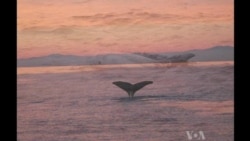LONG BEACH, CALIFORNIA —
Tourists are flocking to the southern California coast for whale-watching tours. In the last month, a record number of the huge marine mammals have been seen off the coast of Long Beach, just south of Los Angeles. Marine biologists are trying to figure out why.
Near two of the busiest ports in the United States, ships are not the only giants moving through the ocean. Captain Dan Salas of Harbor Breeze Cruises has been seeing sprays of water coming out of the ocean, followed by splashes from giant tails.
“In the last month or so we have seen so many whales that it’s been just absolutely incredible,” he said.
Salas runs whale watching cruises off the coast of Long Beach seven days a week throughout the year. He said typically visitors had a 75 to 80 percent chance of seeing a whale.
“We have been 100 percent of the time seeing whales in the last month. Not typical,” said Salas.
Marine biologist Kera Mathes is trying to solve this mystery.
“I’ve been out there for a few years and I’ve never had anything like that before, nor have I ever heard of anything like that before. I think a traffic jam is a good way to talk about it,” she said.
Mathes said it’s been recording-breaking. She’s seen more than double the number of grey whales last month than in previous Decembers. In that same period, she’s also seen many different species in these waters.
“We’ve also had orca sightings here, killer whales. We’ve seen sperm whales. We’ve had a humpback whale in the area; the second largest animal - the fin whale, as well - all within a very short period of time,” Mathes said.
Mathes said the reason for the increased sightings could be that more people are out here looking for whales. The animals could also be swimming closer to shore. Or an increased food supply in these waters could be attracting more whales. Where is that food coming from?
Captain Salas said one theory was that the water in this area was much cleaner these days, bringing in more marine life.
“The water was very polluted back 20 years ago. We’d rarely see a dolphin or sea lion. Now today, the waters here off of Los Angeles are so clean that we almost every day we’ll see dolphins and sea lions before we even leave the harbor,” he said.
Mathes said global climate change could be bringing more food to the area. Climate change could also be causing the whales to shift their migration routes.
Regardless of why the whales are congregating here, tourist Kathy Burton said she was just enjoying nature’s show.
“That was a surprise. I thought that was going to be it, just the one whale, and then the dolphins at the beginning and thought we were going to be heading back,” she said.
But 11 kilometers off shore, the ship came near a pod of whales traveling together, ending another extraordinary trip for the tourists, the boat captain and the scientists on board.
Near two of the busiest ports in the United States, ships are not the only giants moving through the ocean. Captain Dan Salas of Harbor Breeze Cruises has been seeing sprays of water coming out of the ocean, followed by splashes from giant tails.
“In the last month or so we have seen so many whales that it’s been just absolutely incredible,” he said.
Salas runs whale watching cruises off the coast of Long Beach seven days a week throughout the year. He said typically visitors had a 75 to 80 percent chance of seeing a whale.
“We have been 100 percent of the time seeing whales in the last month. Not typical,” said Salas.
Marine biologist Kera Mathes is trying to solve this mystery.
“I’ve been out there for a few years and I’ve never had anything like that before, nor have I ever heard of anything like that before. I think a traffic jam is a good way to talk about it,” she said.
Mathes said it’s been recording-breaking. She’s seen more than double the number of grey whales last month than in previous Decembers. In that same period, she’s also seen many different species in these waters.
“We’ve also had orca sightings here, killer whales. We’ve seen sperm whales. We’ve had a humpback whale in the area; the second largest animal - the fin whale, as well - all within a very short period of time,” Mathes said.
Mathes said the reason for the increased sightings could be that more people are out here looking for whales. The animals could also be swimming closer to shore. Or an increased food supply in these waters could be attracting more whales. Where is that food coming from?
Captain Salas said one theory was that the water in this area was much cleaner these days, bringing in more marine life.
“The water was very polluted back 20 years ago. We’d rarely see a dolphin or sea lion. Now today, the waters here off of Los Angeles are so clean that we almost every day we’ll see dolphins and sea lions before we even leave the harbor,” he said.
Mathes said global climate change could be bringing more food to the area. Climate change could also be causing the whales to shift their migration routes.
Regardless of why the whales are congregating here, tourist Kathy Burton said she was just enjoying nature’s show.
“That was a surprise. I thought that was going to be it, just the one whale, and then the dolphins at the beginning and thought we were going to be heading back,” she said.
But 11 kilometers off shore, the ship came near a pod of whales traveling together, ending another extraordinary trip for the tourists, the boat captain and the scientists on board.






